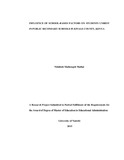| dc.description.abstract | The study aimed at investigating the influence of school-based factors on students
unrest in public secondary schools in Kwale County, Kenya. The study was
guided by the following objectives; to establish how principals management of
access to drugs and substance, teachers‟ use of guidance and counselling,
teachers‟ discipline management approaches and teachers‟ compliance with
children‟s rights influence students‟ unrest in public secondary schools in Kwale
County, Kenya. This study was based on System theory by Ludwig von
Bertalanffy (1996). The study used descriptive survey design. The target
population of this study comprised 60 public secondary schools, 60 principals,
600 teachers, 120 prefects form 3 and 4 classes in Kwale County, Kenya. The
sample size was 240 respondents that included 30 principals, 120 teachers, 60
prefects (form 3 and 4) and 30 school presidents. One hundred and ninety five
responded of which 30 were principals, 95 teachers, 40 prefects form 3 and 4
classes and 30 school presidents. The BOM members were stratified in to two to
involve 8 male and 7 female members from each school. Stratified sampling was
used to select the respondents. Questionnaires for teachers and class prefects and
interview schedules for principals were used for data collection. Reliability
analysis was done through test-retest method. Reliability coefficient of 0.7
deemed the instrument reliable. Validity was ensured through discussion with the
experts including supervisors and colleagues. Primary data was collected and
analyzed using quantitative and qualitative techniques and presented in tables and
graphs. Secondary data was obtained from journals and schools data base. Data
collected was analyzed using SPSS (Statistical Package for Social Sciences).
Descriptive statistics and thematic analysis were used. The findings showed that
the four schools that were effective in the management of access to drugs and
substance abuse in terms of principals‟ management had three cases of school
unrests compared to six for those schools that were not effective in managing
drugs and substances. The study also found out that the two schools which had
teachers‟ practice better guidance and counselling among the students had only
two cases of school unrests compared to six for those schools that did not have
better guidance and counselling. Schools that were effective in using various
discipline approaches and whose teachers complied with children‟s rights had
only one case of students‟ unrest in their secondary schools compared to three for
those schools that lacked. The study recommends that government initiate
programmes that enhance principal‟s management of access to drugs and
substance since the current methods being applied seem not to be effective. This
is because the teachers highlighted lack of proper practices to check on drugs and
substance abuse in the public secondary schools. This can be done through the
DEOs and principals in the public secondary schools. There should be further
research on the influence of head teachers‟ leadership styles on students‟ unrest in
public secondary schools in Kwale County, and the effect of teacher – students‟
ratio on student unrest in public secondary schools in Kwale County, Kenya. | en_US |

